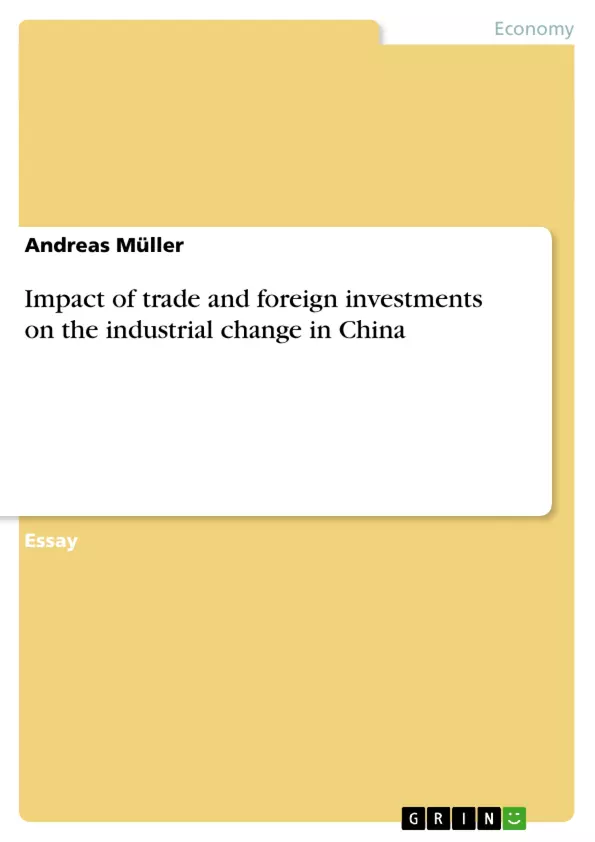Since 1978 the economic reform process in China has been in progress. It transformed the economy of the People’s Republic of China (PRC) from a centrally planned into a socialist market economy with Chinese characteristics. A basic feature of this reformation was the encouragement of foreign direct investment inflows as well as the liberalization of trade in China.
In the present essay, I will trace the evolution of trade patterns together with their associated consequences on China’s industrial structure.
Inhaltsverzeichnis (Table of Contents)
- Introduction
- Trade in China
- Import and export patterns
- Evolution of trade
- Liberalization of trade
- Impact of Trade and investments on the industrial structural change in China
- Ownership restructuring
- China's expansion in high-tech market
- Conclusion
Zielsetzung und Themenschwerpunkte (Objectives and Key Themes)
This essay examines the evolution of trade patterns in China since the economic reforms of 1978 and their impact on the country's industrial structure. The author traces the transformation of China's economy from a centrally planned system to a socialist market economy. Key themes explored in the essay include:- The impact of trade liberalization on China's industrial structure
- The role of foreign direct investment in promoting industrial change
- The evolution of China's comparative advantages in international trade
- The impact of trade on ownership restructuring in the Chinese economy
- The shift in China's export patterns towards high-tech manufacturing.
Zusammenfassung der Kapitel (Chapter Summaries)
Introduction
The essay begins by outlining the economic reforms in China since 1978, highlighting the transition to a socialist market economy and the crucial role of foreign direct investment and trade liberalization in this process.Trade in China
This section explores China's trade patterns, starting with an analysis of its export and import structure. It identifies the traditional labor-intensive goods that China exported in the 1980s and the shift towards manufacturing products, particularly high-tech goods. The evolution of trade volumes and China's growing position in global trade is also discussed, showcasing China's rise from a minor player in international trade to a leading exporter.Impact of Trade and Investments on the industrial structural change in China
This section delves into the influence of trade and investment on the transformation of China's industrial structure. The author examines how ownership restructuring has occurred, moving away from a centrally planned economy towards a more market-oriented model. The impact of foreign investment on China's expansion into high-tech markets is also discussed.Schlüsselwörter (Keywords)
The central focus of this essay is the impact of trade and foreign investment on the industrial transformation of China. Key terms and concepts include: * **Trade liberalization** * **Foreign Direct Investment (FDI)** * **Industrial structural change** * **Comparative advantage** * **High-tech manufacturing** * **Ownership restructuring** * **Socialist market economy** * **Global trade**
Fin de l'extrait de 10 pages
- haut de page
- Citation du texte
- Andreas Müller (Auteur), 2011, Impact of trade and foreign investments on the industrial change in China, Munich, GRIN Verlag, https://www.grin.com/document/198566
Lire l'ebook



